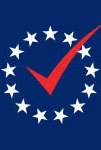Boardroom Voting: Verifiable Voting with Ballot Privacy Using Low-Tech Cryptography in a Single Room
Working Paper No.: 142
Date Published: 2020-08-19
Author(s):
Enka Blanchard, Digitrust, Loria, Université de Lorraine
Ted Selker, University of California Berkeley and UMBC
Alan T. Sherman, Cyber Defense Lab, University of Maryland, Baltimore County (UMBC)
Abstract:
A boardroom election is an election that takes place in a single room — the boardroom — in which all voters can see and hear each other. We present an initial exploration of boardroom elections with ballot privacy and voter verifiability that use only “low-tech cryptography” without using computers to mark or collect ballots. Specifically, we define the problem, introduce several building blocks, and propose a new protocol that combines these blocks in novel ways. Our new building blocks include “foldable ballots” that can be rotated to hide the alignment of ballot choices with voting marks, and “visual secrets” that are easy to remember and use but hard to describe. Although closely seated participants in a boardroom election have limited privacy, the protocol ensures that no one can determine how others voted. Moreover, each voter can verify that their ballot was correctly cast, collected, and counted, without being able to prove how they voted, providing assurance against undue influence. Low-tech cryptography is useful in situations where constituents do not trust computer technology, and it avoids the complex auditing requirements of end-to-end cryptographic voting systems such as Prêt-à-Voter. This paper’s building blocks and protocol are meant to be a proof of concept that might be tested for usability and improved.
Attachment
 Boardroom Voting: Verifiable Voting with Ballot Privacy Using Low-Tech Cryptography in a Single Room
(Size: 1587 KB)
Boardroom Voting: Verifiable Voting with Ballot Privacy Using Low-Tech Cryptography in a Single Room
(Size: 1587 KB)
